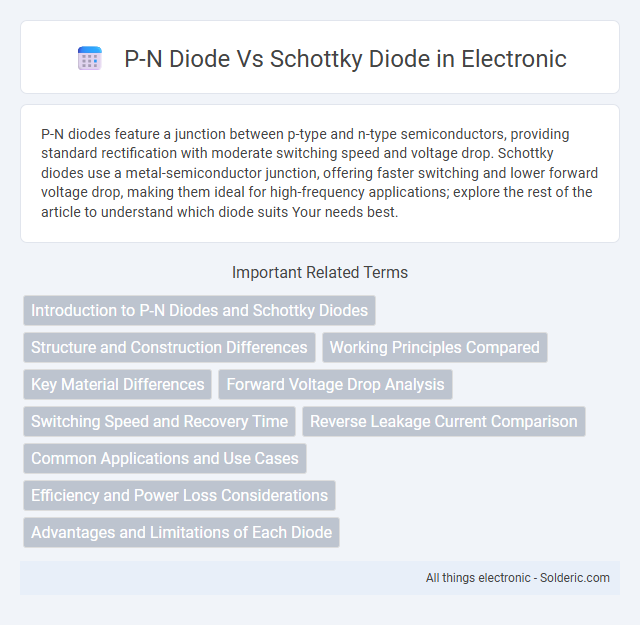P-N diodes feature a junction between p-type and n-type semiconductors, providing standard rectification with moderate switching speed and voltage drop. Schottky diodes use a metal-semiconductor junction, offering faster switching and lower forward voltage drop, making them ideal for high-frequency applications; explore the rest of the article to understand which diode suits Your needs best.
Comparison Table
| Feature | P-N Diode | Schottky Diode |
|---|---|---|
| Construction | PN junction (p-type and n-type semiconductor) | Metal-semiconductor junction |
| Forward Voltage Drop | 0.7 V (Silicon) | 0.2 - 0.3 V |
| Switching Speed | Slower | Faster, ideal for high-speed switching |
| Reverse Recovery Time | Longer | Very short |
| Leakage Current | Low | Higher than PN diode |
| Applications | General rectification, switching | High-frequency rectification, power supply, RF applications |
| Temperature Sensitivity | Moderate | Higher sensitivity |
| Cost | Lower | Higher |
Introduction to P-N Diodes and Schottky Diodes
P-N diodes consist of a junction formed by p-type and n-type semiconductors, allowing current to flow in one direction with a relatively higher forward voltage drop. Schottky diodes, characterized by a metal-semiconductor junction, provide faster switching speeds and lower forward voltage drop than P-N diodes, making them ideal for high-frequency applications. Understanding the distinct electrical properties of these diodes helps you select the right component for efficiency and performance in rectification and signal processing tasks.
Structure and Construction Differences
A P-N diode consists of a junction formed by p-type and n-type semiconductor materials, creating a depletion region that controls current flow. A Schottky diode, on the other hand, is constructed with a metal-semiconductor junction, typically metal and n-type semiconductor, which results in faster switching speeds and lower forward voltage drop. Understanding these structural differences can help optimize your circuit design depending on the required performance characteristics.
Working Principles Compared
P-N diodes operate based on the junction between p-type and n-type semiconductors, allowing current flow when forward biased through the diffusion of charge carriers across the depletion region. Schottky diodes use a metal-semiconductor junction instead, resulting in lower forward voltage drop and faster switching speeds due to majority carrier conduction. Your choice between P-N and Schottky diodes depends on requirements for switching speed, forward voltage, and reverse recovery characteristics in electronic circuits.
Key Material Differences
P-N diodes are made by joining p-type and n-type semiconductor materials, typically silicon, creating a depletion region that controls current flow. Schottky diodes use a metal-semiconductor junction, often between platinum or tungsten and n-type silicon, resulting in a lower forward voltage drop and faster switching speed. The metal-semiconductor interface in Schottky diodes eliminates charge storage effects found in P-N junctions, enhancing efficiency in high-frequency applications.
Forward Voltage Drop Analysis
P-N diodes typically exhibit a forward voltage drop around 0.7 volts due to the energy required to overcome the depletion region in the semiconductor junction. Schottky diodes feature a lower forward voltage drop, usually between 0.15 and 0.45 volts, resulting from the metal-semiconductor junction that enables faster switching and reduced power loss. This low forward voltage drop makes Schottky diodes ideal for high-efficiency power applications and low-voltage rectification.
Switching Speed and Recovery Time
P-N diodes have slower switching speeds and longer recovery times due to their minority carrier charge storage, making them less efficient in high-frequency applications. Schottky diodes feature faster switching speeds and minimal recovery time because they rely on majority carriers only, reducing charge storage effects. Your choice between these diodes impacts performance, especially in circuits requiring rapid switching and low power loss.
Reverse Leakage Current Comparison
P-N diodes exhibit significantly lower reverse leakage current compared to Schottky diodes due to their p-n junction structure, which provides better blocking capability under reverse bias. Schottky diodes, constructed with a metal-semiconductor junction, inherently have higher reverse leakage current, making them less suitable for applications requiring minimal leakage. Understanding this difference helps you select the appropriate diode type for low-leakage or high-speed switching circuits.
Common Applications and Use Cases
P-N diodes are commonly used in rectification, signal demodulation, and voltage regulation due to their higher forward voltage drop and slower switching characteristics. Schottky diodes find widespread applications in high-speed switching, power rectification in power supplies, and RF circuits because of their low forward voltage drop and fast recovery time. Their unique electrical properties make Schottky diodes ideal for low-voltage, high-frequency, and low-loss operations compared to traditional P-N junction diodes.
Efficiency and Power Loss Considerations
P-N diodes exhibit higher forward voltage drops typically around 0.7V, leading to greater power loss and reduced efficiency in high-current applications compared to Schottky diodes, which have forward voltage drops of approximately 0.2 to 0.3V. Schottky diodes offer faster switching speeds and lower junction capacitance, contributing to improved efficiency and reduced heat generation in power rectification and RF circuits. The lower forward voltage and minimal reverse recovery time of Schottky diodes result in significantly lower conduction and switching losses, making them preferable for power-efficient designs.
Advantages and Limitations of Each Diode
P-N diodes offer higher voltage blocking capabilities and better reverse recovery characteristics, making them suitable for general rectification and switching applications, but they suffer from slower switching speeds and higher forward voltage drops compared to Schottky diodes. Schottky diodes provide faster switching speeds and lower forward voltage drops, which enhance efficiency and reduce power loss in high-frequency circuits, yet they have lower reverse voltage ratings and higher leakage currents that limit their usage under high-voltage conditions. Your choice depends on whether your application prioritizes efficient high-speed switching with low forward voltage or robust high-voltage performance with slower recovery.
P-N diode vs Schottky diode Infographic

 solderic.com
solderic.com